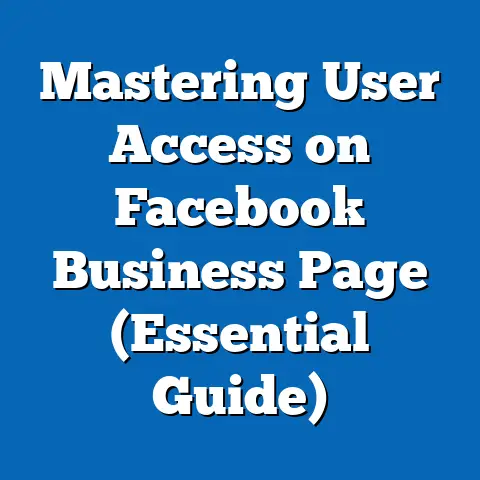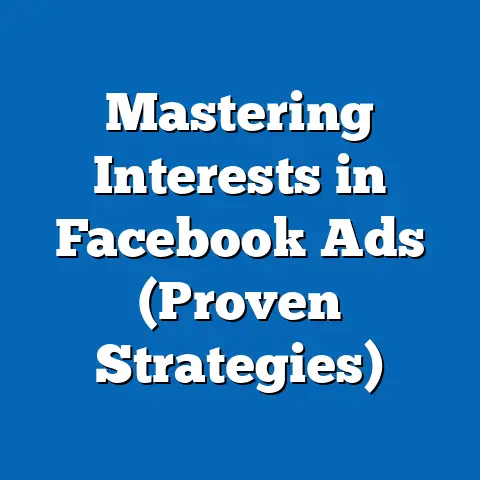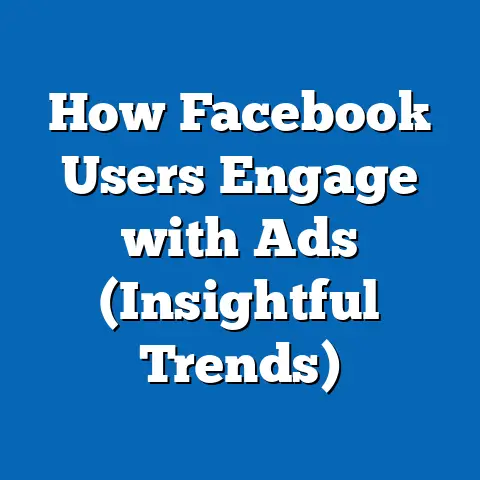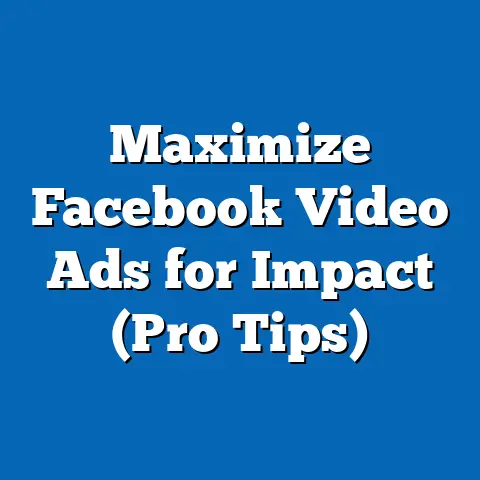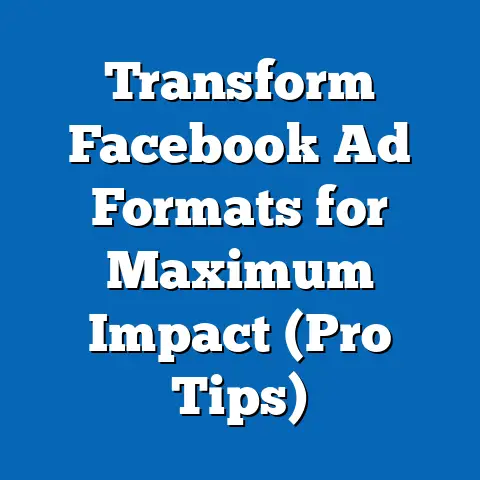Are Facebook and Instagram Ads the Same? (Key Differences)
Imagine you’re a small business owner, juggling a million tasks and trying to make every marketing dollar count. You’ve heard whispers of Facebook ads being conversion powerhouses, but your gut tells you your younger audience is practically living on Instagram. Should you dedicate your precious time and budget to Facebook, or is Instagram the smarter bet? This is a conundrum I see countless entrepreneurs face, and it highlights a crucial question: Are Facebook and Instagram ads truly the same, or do they operate on entirely different playing fields?
In today’s digital marketing arena, where social media reigns supreme, both Facebook and Instagram offer enticing advertising opportunities. As platforms, they boast massive user bases and sophisticated targeting capabilities. But beneath the surface, significant differences exist that can make or break your campaign. This article will dissect these differences, offering a comprehensive comparison of Facebook and Instagram ads to help you make informed decisions and maximize your ROI.
Understanding the Platforms: A Tale of Two Worlds
To truly grasp the nuances of Facebook and Instagram advertising, we need to understand the fundamental nature of each platform.
Facebook: Think of Facebook as the town square. It’s a place where people connect with friends and family, join communities, share news, and engage in discussions. Born in 2004, Facebook has evolved into a sprawling social network with a diverse user base spanning all age groups, interests, and demographics. Its strength lies in its ability to foster connections and facilitate meaningful interactions. I’ve personally witnessed how Facebook groups can become thriving communities, driving engagement and brand loyalty.
Instagram: On the other hand, Instagram is the art gallery. Launched in 2010, it’s a visually driven platform where users share photos and videos, showcasing their creativity and capturing life’s moments. Instagram skews younger, attracting a demographic that values aesthetics, trends, and visual storytelling. It’s a place for inspiration, discovery, and aspirational content. I’ve seen firsthand how brands leverage Instagram’s visual appeal to create stunning campaigns that capture attention and drive desire.
The Facebook-Instagram Connection: While distinct, it’s crucial to remember that Facebook acquired Instagram in 2012. This integration means that you can manage your advertising campaigns for both platforms through a single interface: Facebook Ads Manager. This makes cross-platform advertising more efficient, but it doesn’t erase the inherent differences between the platforms themselves.
Takeaway: Understanding the unique characteristics and user engagement patterns of Facebook and Instagram is the first step toward crafting effective advertising strategies.
Advertising Objectives and Goals: What Are You Trying to Achieve?
Before diving into ad formats and targeting options, it’s essential to define your advertising objectives. What are you hoping to accomplish with your campaigns? The answer to this question will heavily influence which platform is the better fit.
Facebook’s Strengths: Facebook excels at achieving a wide range of marketing goals, including:
- Brand Awareness: Reaching a broad audience and increasing brand visibility.
- Lead Generation: Collecting contact information from potential customers.
- Website Traffic: Driving traffic to your website or landing pages.
- Conversions: Encouraging specific actions, such as purchases, sign-ups, or downloads.
- App Installs: Promoting mobile app downloads.
Instagram’s Focus: Instagram shines when it comes to:
- Visual Storytelling: Showcasing your brand’s personality and values through compelling visuals.
- Engagement: Encouraging likes, comments, shares, and follows.
- Product Discovery: Introducing new products and services through visually appealing content.
- Influencer Marketing: Collaborating with influencers to reach a wider audience.
Personal Anecdote: I once worked with a local bakery that wanted to increase its online orders. We ran targeted Facebook ads offering a discount code for first-time customers. The campaign was a resounding success, generating a significant increase in website traffic and online sales. For this client, Facebook’s ability to drive conversions was the key to their success.
Takeaway: Choose the platform that best aligns with your specific advertising objectives. If you’re focused on driving conversions or generating leads, Facebook might be the better choice. If you’re looking to build brand awareness or showcase visually appealing products, Instagram could be your sweet spot.
Target Demographics: Who Are You Trying to Reach?
Understanding the demographics of users on both platforms is critical for effective targeting. While there’s overlap, significant differences exist that can impact your ad strategy.
Facebook Demographics:
- Age: Facebook boasts a diverse age range, with a large percentage of users aged 25-54.
- Gender: The platform has a relatively balanced gender distribution.
- Interests: Facebook’s detailed targeting options allow you to reach users based on their interests, hobbies, behaviors, and demographics.
- Location: You can target users based on their location, from broad geographic regions to specific zip codes.
Instagram Demographics:
- Age: Instagram skews younger, with a large percentage of users aged 18-34.
- Gender: The platform tends to attract a slightly larger female audience.
- Interests: Instagram’s visual nature makes it ideal for targeting users based on their interests in fashion, beauty, travel, and lifestyle.
- Location: Similar to Facebook, you can target users based on their location.
Statistics to Consider:
- According to Statista, as of January 2024, Facebook has over 3 billion monthly active users worldwide, while Instagram has over 2 billion.
- Pew Research Center data indicates that while Facebook is used by a wide range of adults, Instagram is particularly popular among younger adults and teenagers.
Personal Insight: I’ve found that Facebook’s detailed targeting options are invaluable for reaching niche audiences. For example, I once ran a campaign for a local antique store targeting users interested in vintage furniture, historical artifacts, and local history. The campaign generated a high level of engagement and drove significant foot traffic to the store.
Takeaway: Analyze your target audience’s demographics and choose the platform where they are most likely to be active. If you’re targeting a younger demographic, Instagram might be the better choice. If you’re targeting a broader audience or specific interest groups, Facebook could be more effective.
Ad Formats and Creative Opportunities: Telling Your Story
The ad formats available on each platform offer different creative opportunities for showcasing your brand and message.
Facebook Ad Formats:
- Image Ads: Single image ads are simple and effective for capturing attention.
- Video Ads: Video ads are highly engaging and can be used to tell compelling stories.
- Carousel Ads: Carousel ads allow you to showcase multiple images or videos in a single ad unit.
- Slideshow Ads: Slideshow ads combine multiple images into a video-like format.
- Collection Ads: Collection ads are designed for e-commerce businesses, allowing users to browse and purchase products directly from the ad.
Instagram Ad Formats:
- Photo Ads: Similar to image ads on Facebook, photo ads are visually appealing and can be used to showcase products or services.
- Video Ads: Video ads are highly engaging and can be used to tell stories or demonstrate product features.
- Carousel Ads: Carousel ads allow you to showcase multiple images or videos in a single ad unit.
- Story Ads: Story ads are immersive, full-screen ads that appear between users’ Instagram stories.
- Shopping Ads: Shopping ads allow users to purchase products directly from your Instagram feed or stories.
The Power of Visuals on Instagram: Instagram’s visually driven nature demands high-quality, engaging visuals. Your ads should be aesthetically pleasing and aligned with your brand’s overall aesthetic. I’ve seen brands create stunning Instagram feeds that seamlessly blend organic and paid content, creating a cohesive and captivating experience for users.
Takeaway: Consider the ad formats that best suit your brand and message. If you have high-quality visuals, Instagram might be the ideal platform. If you need to convey more information or tell a longer story, Facebook’s diverse ad formats could be more effective.
User Engagement and Interaction: Building Relationships
Understanding how users interact with ads on each platform is crucial for optimizing your campaigns.
Facebook’s Focus on Community: Facebook encourages community engagement through comments, shares, and reactions. Users can easily interact with ads, ask questions, and share their opinions. This can be a valuable opportunity to build relationships with potential customers and address their concerns.
Instagram’s Emphasis on Visual Appeal: Instagram prioritizes visual appeal and quick interactions. Users are more likely to like, comment, or send a direct message (DM) in response to an ad. This makes Instagram ideal for driving engagement and building brand awareness.
Personal Experience: I once ran a Facebook ad campaign for a local restaurant that encouraged users to share their favorite dishes in the comments. The campaign generated a high level of engagement, with users tagging their friends and sharing photos of their meals. This not only increased brand awareness but also provided valuable social proof.
Takeaway: Consider how users are likely to interact with your ads on each platform. If you want to foster community engagement and encourage discussions, Facebook might be the better choice. If you’re focused on driving quick interactions and building brand awareness, Instagram could be more effective.
Performance Metrics and Analytics: Measuring Success
Tracking your ad performance is essential for optimizing your campaigns and maximizing your ROI. Both Facebook and Instagram offer robust analytics tools that allow you to measure key metrics.
Key Metrics to Track:
- Click-Through Rate (CTR): The percentage of users who click on your ad.
- Conversion Rate: The percentage of users who complete a desired action after clicking on your ad (e.g., purchase, sign-up, download).
- Cost Per Click (CPC): The average cost you pay for each click on your ad.
- Cost Per Thousand Impressions (CPM): The average cost you pay for every 1,000 impressions of your ad.
- Engagement Rate: The percentage of users who interact with your ad (e.g., likes, comments, shares).
- Return on Ad Spend (ROAS): The amount of revenue you generate for every dollar you spend on advertising.
Understanding the Metrics:
- A high CTR indicates that your ad is relevant and engaging.
- A high conversion rate indicates that your landing page is effective and your offer is compelling.
- A low CPC indicates that your targeting is efficient and your ad is performing well.
- A high engagement rate indicates that your ad is resonating with your target audience.
- A positive ROAS indicates that your advertising campaign is profitable.
Takeaway: Monitor your ad performance closely and use the data to optimize your campaigns. Experiment with different targeting options, ad formats, and creative elements to see what works best for your brand.
Cost and Budget Considerations: Making the Most of Your Money
The cost of advertising on Facebook and Instagram can vary depending on a variety of factors, including your target audience, ad format, bidding strategy, and competition.
Factors Influencing Cost:
- Target Audience: Targeting a highly competitive audience will typically result in higher costs.
- Ad Format: Video ads tend to be more expensive than image ads.
- Bidding Strategy: Choosing a manual bidding strategy allows you to control your costs more closely.
- Competition: The more advertisers competing for the same audience, the higher the costs will be.
Average Costs:
- According to WordStream, the average CPC for Facebook ads is around \$0.97, while the average CPC for Instagram ads is around \$3.56.
- However, these are just averages, and your actual costs may vary significantly.
Budgeting Tips:
- Start with a small budget and gradually increase it as you optimize your campaigns.
- Use A/B testing to experiment with different ad formats and targeting options.
- Monitor your ad performance closely and adjust your budget accordingly.
- Consider using a lifetime budget to control your overall spending.
Takeaway: Develop a realistic budget based on your advertising goals and target audience. Experiment with different bidding strategies and ad formats to find the most cost-effective approach.
Case Studies and Real-World Examples: Learning from Success
Analyzing successful ad campaigns on both platforms can provide valuable insights and inspiration.
Facebook Success Story: A local gym used Facebook ads to generate leads for its personal training program. The campaign targeted users interested in fitness, weight loss, and healthy eating. The ads featured before-and-after photos of satisfied clients and offered a free consultation. The campaign generated a significant number of leads, resulting in a substantial increase in personal training clients.
Instagram Success Story: A fashion boutique used Instagram ads to showcase its latest collection. The ads featured visually stunning photos of models wearing the boutique’s clothing. The ads targeted users interested in fashion, style, and beauty. The campaign generated a high level of engagement and drove significant traffic to the boutique’s website.
Key Lessons Learned:
- Relevance is Key: Your ads should be highly relevant to your target audience’s interests and needs.
- Visuals Matter: High-quality visuals are essential for capturing attention and driving engagement.
- Call to Action: Your ads should include a clear and compelling call to action.
- A/B Testing: Experiment with different ad formats, targeting options, and creative elements to see what works best.
Takeaway: Study successful ad campaigns on both platforms and identify the strategies that resonated with their target audiences. Adapt these strategies to your own campaigns, but always remember to test and optimize to find what works best for your brand.
Conclusion: Choosing the Right Path
In conclusion, while Facebook and Instagram ads share similarities, they are not interchangeable. Their unique features, user demographics, and engagement patterns cater to different marketing strategies. Facebook excels at driving conversions, generating leads, and reaching a broad audience, while Instagram shines at building brand awareness, showcasing visually appealing products, and engaging with a younger demographic.
The key to success lies in understanding your target audience, defining your advertising objectives, and choosing the platform that best aligns with your goals. By carefully considering the factors outlined in this article, you can make informed decisions and maximize your advertising ROI.
Ultimately, the choice between Facebook and Instagram ads is not about which platform is “better,” but rather about which platform is the best fit for your specific business needs. So, take the time to analyze your audience, define your goals, and experiment with different strategies. The world of social media advertising is constantly evolving, and the only way to stay ahead is to be adaptable, data-driven, and willing to learn.

